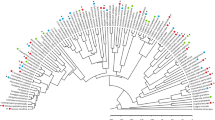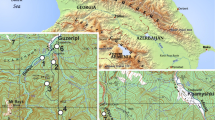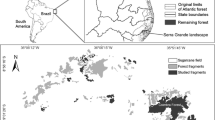Abstract
It is debated whether slowing human population growth and intense urbanization may result in a slowdown of deforestation and an acceleration of natural forest regeneration. In a fragmented landscape the structure and composition of developing secondary forests will strongly depend on the local species pool. Thus, the understanding how organisms cope with biotic and abiotic challenges outside pristine habitats is pivotal. Structurally dependent, vascular epiphytes are an important biotic component of tropical forests. In human-modified tropical landscapes potential hosts are often still present. We aimed to assess if human-modified landscapes offer a refuge habitat in which epiphytes can form metacommunities that are ultimately viable. Eight years after an initial assessment we recensused the epiphytes in pasture trees in western Panama along a strong rainfall gradient. We document a threefold abundance increase (ca. 20,000 vs. >60,000 individuals) and an increase in species-richness (66 vs. 86 mostly drought-tolerant species). This large net increase suggests a highly dynamic system. Although absolute abundances changed dramatically, the relative contribution of major taxonomic groups to overall diversity and abundance changed little. Neither rainfall nor tree growth had a significant effect on relative annual community growth rates. At the plot level (=metacommunities), abundance increase was mostly due to the species already present in the first census, at the tree level (=communities) the contribution of new and old species was comparable. The documented long-term trend in epiphyte metacommunities in a human-modified landscape suggests that a diverse set of species sustains viable metacommunities and is likely to provide structural diversity to developing secondary forest.




Similar content being viewed by others
References
Adhikari YP, Fischer A, Fischer HS (2012) Micro-site conditions of epiphytic orchids in a human impact gradient in Kathmandu valley, Nepal. J Mt Sci 9:331–342. doi:10.1007/s11629-009-2262-1
Atlas Nacional de la República de Panamá (1988) Instituto Geográfico Nacional ‘‘Tommy Guardia’’, Panamá
Aubad J, Aragón P, Rodríguez MÁ (2010) Human access and landscape structure effects on Andean forest bird richness. Acta Oecol 36:396–402. doi:10.1016/j.actao.2010.03.009
Bakayoko A, Martin P, Chatelain C, Traore D, Gautier L (2011) Diversity, family dominance, life forms and ecological strategies of forest fragments compared to continuous forest in southwestern Cote d’lvoire. Candollea 66:255–262
Blick R, Burns KC (2009) Network properties of arboreal plants: are epiphytes, mistletoes and lianas structured similarly? Perspect Plant Ecol Evol Syst 11:41–52. doi:10.1016/j.ppees.2008.10.002
Brook BW, Bradshaw CJA, Koh LP, Sodhi NS (2006) Momentum drives the crash: mass extinction in the tropics. Biotropica 38:302–305. doi:10.1111/j.1744-7429.2006.00141.x
Burns KC, Zotz G (2010) A hierarchical framework for investigating epiphyte assemblages: networks, metacommunities and scale. Ecology 91:377–385
Chazdon RL et al (2009) Beyond reserves: a research agenda for conserving biodiversity in human-modified tropical landscapes. Biotropica 41:142–153. doi:10.1111/j.1744-7429.2008.00471.x
Condit R, Hubbell SP, Foster RB (1995) Mortality rates of 205 neotropical tree and shrub species and the impact of severe drought. Ecol Monogr 65:419–439
Correa A, Mireya D, Galdames C, de Stampf MS (2004) Catálogo de las Plantas Vasculares de Panamá. Universidad de Panamá y Instituto Smithsonian de Investigaciones Tropicales, Panamá
Crayn DM, Winter K, Smith JAC (2004) Multiple origins of crassulacean acid metabolism and the epiphytic habit in the Neotropical family Bromeliaceae. Proc Natl Acad Sci USA 101:3703–3708
Einzmann HJR, Zotz G (2016) How diverse are epiphyte assemblages in plantations and secondary forests in tropical lowlands? Trop Conserv Sci 9:629–647
Einzmann HJR, Beyschlag J, Hofhansl F, Wanek W, Zotz G (2015) Host tree phenology affects vascular epiphytes at the physiological, demographic and community level. AoB PLANTS 7:plu073. doi:10.1093/aobpla/plu073
FAO (2010) Global forest resources assessment 2010: main report. Food and Agriculture Organization of the United Nations, Rome
Feeley KJ, Davies SJ, Perez R, Hubbell SP, Foster RB (2011) Directional changes in the species composition of a tropical forest. Ecology 92:871–882. doi:10.1890/10-0724.1
Floren A, Mueller T, Deeleman-Reinhold C, Linsenmair KE (2011) Effects of forest fragmentation on canopy spider communities in SE-Asian rain forests. Ecotropica 17:15–26
Flores-Palacios A, García-Franco JG (2001) Sampling methods for vascular epiphytes: their effectiveness in recording species richness and frequency. Selbyana 22:181–191
Flores-Palacios A, García-Franco JG (2006) The relationship between tree size and epiphyte species richness: testing four different hypotheses. J Biogeogr 33:323–330. doi:10.1111/j.1365-2699.2005.01382.x
Hanski I, Gilpin ME (1997) Metapopulation biology: ecology, genetics, and evolution. Academic Press, San Diego
Heckadon-Moreno S (2009) De selvas a potreros, 1st edn. Exedra Books, Panamá
Hietz P, Wanek W, Popp M (1999) Stable isotopic composition of carbon and nitrogen and nitrogen content in vascular epiphytes along an altitudinal transect. Plant, Cell Environ 22:1435–1443
Hietz-Seifert U, Hietz P, Guevara S (1996) Epiphyte vegetation and diversity on remnant trees after forest clearance in southern Veracruz, Mexico. Biol Conserv 75:103–111
Johst K, Brandl R, Eber S (2002) Metapopulation persistence in dynamic landscapes: the role of dispersal distance. Oikos 98:263–270. doi:10.1034/j.1600-0706.2002.980208.x
Köster N, Friedrich K, Nieder J, Barthlott W (2009) Conservation of epiphyte diversity in an Andean landscape transformed by human land use. Conserv Biol 23:911–919. doi:10.1111/j.1523-1739.2008.01164.x
Larrea ML, Werner FA (2010) Response of vascular epiphyte diversity to different land-use intensities in a neotropical montane wet forest. For Ecol Manage 260:1950–1955. doi:10.1016/j.foreco.2010.08.029
Laube S, Zotz G (2006) Long-term changes of the vascular epiphyte assemblage on the palm Socratea exorrhiza in a lowland forest in Panama. J Veg Sci 17:307–314. doi:10.1111/j.1654-1103.2006.tb02450.x
Laube S, Zotz G (2007) A metapopulation approach to the analysis of long term changes in the epiphyte vegetation on the host tree Annona glabra. J Veg Sci 18:613–624
Laurance WF (2007) Have we overstated the tropical biodiversity crisis? Trends Ecol Evol 22:65–70. doi:10.1016/j.tree.2006.09.014
Laurance WF et al (2002) Ecosystem decay of Amazonian forest fragments: a 22-year investigation. Conserv Biol 16:605–618. doi:10.1046/j.1523-1739.2002.01025.x
Laurance WF et al (2012) Averting biodiversity collapse in tropical forest protected areas. Nature 489:290–294. doi:10.1038/nature11318
Löbel S, Rydin H (2009) Dispersal and life history strategies in epiphyte metacommunities: alternative solutions to survival in patchy, dynamic landscapes. Oecologia 161:569–579. doi:10.1007/s00442-009-1402-1
Magrach A, Rodríguez-Pérez J, Piazzon M, Santamaría L (2015) Divergent effects of forest edges on host distribution and seed disperser activity influence mistletoe distribution and recruitment. J Ecol 103:1475–1486. doi:10.1111/1365-2745.12472
Mendieta-Leiva G, Zotz G (2015) A conceptual framework for the analysis of vascular epiphyte assemblages. Perspect Plant Ecol Evol Syst 17:510–521. doi:10.1016/j.ppees.2015.09.003
Mondragón D, Calvo-Irabien M (2006) Seed dispersal and germination of the epiphyte Tillandsia brachycaulos (Bromeliaceae) in a tropical dry forest, Mexico. Southwest Nat 51:462–470
Mondragón D, Valverde T, Hernandez-Apolinar M (2015) Population ecology of epiphytic angiosperms: a review. Trop Ecol 56:1–39
Norris K, Asase A, Collen B, Gockowksi J, Mason J, Phalan B, Wade A (2010) Biodiversity in a forest-agriculture mosaic: the changing face of West African rainforests. Biol Conserv 143:2341–2350. doi:10.1016/j.biocon.2009.12.032
Norton DA, Carpenter MA (1998) Mistletoes as parasites: host specificity and speciation. Trends Ecol Evol 13:101–105. doi:10.1016/S0169-5347(97)01243-3
Overton JM (1994) Dispersal and infection in mistletoe metapopulations. J Ecol 82:711–723. doi:10.2307/2261437
Paggi GM et al (2010) Seed dispersal and population structure in Vriesea gigantea, a bromeliad from the Brazilian Atlantic Rainforest. Bot J Linn Soc 164:317–325. doi:10.1111/j.1095-8339.2010.01088.x
Poltz K, Zotz G (2011) Vascular epiphytes on isolated pasture trees along a rainfall gradient in the lowlands of Panama. Biotropica 43:165–172. doi:10.1111/j.1744-7429.2010.00669.x
R Core Team (2013) R: A language and environment for statistical computing. R version 3.0.2 edn. R Foundation for Statistical Computing, Vienna
Restrepo C, Sargent S, Levey DJ, Watson DM (2002) The role of vertebrates in the diversification of New World mistletoes. In: Levey DJ, Silva WR, Galetti M (eds) Seed dispersal and frugivory: ecology, evolution and conservation. CABI Publishing, New York, pp 83–98. doi:10.1079/9780851995250.0083
Sanford WW (1968) Distribution of epiphytic orchids in semi-deciduous tropical forest in southern Nigeria. J Ecol 56:697–705
Saunders DA, Hobbs RJ, Margules CR (1991) Biological consequences of ecosystem fragmentation—a review. Conserv Biol 5:18–32. doi:10.1111/j.1523-1739.1991.tb00384.x
Scalon MC, Wright IJ (2015) A global analysis of water and nitrogen relationships between mistletoes and their hosts: broad-scale tests of old and enduring hypotheses. Funct Ecol 29:1114–1124. doi:10.1111/1365-2435.12418
Schmit-Neuerburg VM (2002) Dynamics of vascular epiphyte vegetation in the Venezuelan lowland rain forest of the Surumoni Crane Project. Dissertation, Rheinischen Friedrich-Wilhelms-Universität Bonn
Silvera K, Santiago LS, Cushman JC, Winter K (2010) The incidence of crassulacean acid metabolism in Orchidaceae derived from carbon isotope ratios: a checklist of the flora of Panama and Costa Rica. Bot J Linn Soc 163:194–222. doi:10.1111/j.1095-8339.2010.01058.x
Snäll T, Riberiro PJ, Rydin H (2003) Spatial occurrence and colonisations in patch-tracking metapopulations: local conditions versus dispersal. Oikos 103:566–578
Taylor A, Burns K (2015) Epiphyte community development throughout tree ontogeny: an island ontogeny framework. J Veg Sci 26:902–910. doi:10.1111/jvs.12289
The Plant List (2013) Version 1.1. Published on the Internet. http://www.theplantlist.org/. Accessed January 2015. vol Version 1.1
Trapnell DW, Hamrick JL (2004) Partitioning nuclear and chloroplast variation at multiple spatial scales in the neotropical epiphytic orchid, Laelia rubescens. Mol Ecol 13:2655–2666. doi:10.1111/j.1365-294X.2004.02281.x
Turner EC, Foster WA (2009) The impact of forest conversion to oil palm on arthropod abundance and biomass in Sabah, Malaysia. J Trop Ecol 25:23–30. doi:10.1017/S0266467408005658
Volkov I, Banavar JR, Hubbell SP, Maritan A (2003) Neutral theory and relative species abundance in ecology. Nature 424:1035–1037
Werner FA (2011) Reduced growth and survival of vascular epiphytes on isolated remnant trees in a recent tropical montane forest clear-cut. Basic Appl Ecol 12:172–181. doi:10.1016/j.baae.2010.11.002
Werner FA, Gradstein SR (2008) Seedling establishment of vascular epiphytes on isolated and enclosed forest trees in an Andean landscape, Ecuador. Biodivers Conserv 17:3195–3207. doi:10.1007/s10531-008-9421-5
Werner FA, Gradstein SR (2009) Diversity of dry forest epiphytes along a gradient of human disturbance in the tropical Andes. J Veg Sci 20:59–68. doi:10.3170/2008-8-18466
Werner FA, Homeier J, Gradstein SR (2005) Diversity of vascular epiphytes on isolated remnant trees in the montane forest belt of southern Ecuador. Ecotropica 11:21–40
Winkler M, Hülber K, Hietz P (2009) Population dynamics of epiphytic orchids in a metapopulation context. Ann Bot 104:995–1004. doi:10.1093/aob/mcp188
Wolf JHD (2005) The response of epiphytes to anthropogenic disturbance of pine-oak forests in the highlands of Chiapas, Mexico. For Ecol Manag 212:367–393. doi:10.1016/j.foreco.2005.03.027
Woods CL, Cardelús CL, DeWalt SJ (2015) Microhabitat associations of vascular epiphytes in a wet tropical forest canopy. J Ecol 103:421–430. doi:10.1111/1365-2745.12357
Wright SJ (2010) The future of tropical forests. Ann N Y Acad Sci 1195:1–27. doi:10.1111/j.1749-6632.2010.05455.x
Wright SJ, Muller-Landau HC (2006) The future of tropical forest species. Biotropica 38:287–301. doi:10.1111/j.1744-7429.2006.00154.x
Zotz G (1998) Demography of the epiphytic orchid, Dimerandra emarginata. J Trop Ecol 14:725–741
Zotz G (2016) Plants on plants: the biology of vascular epiphytes. Fascinating life sciences. Springer, Basel
Zotz G, Bader MY (2009) Epiphytic plants in a changing world: global change effects on vascular and non-vascular epiphytes. Prog Bot 70:147–170. doi:10.1007/978-3-540-68421-3
Zotz G, Hietz P (2001) The physiological ecology of vascular epiphytes: current knowledge, open questions. J Exp Bot 52:2067–2078
Zotz G, Ziegler H (1997) The occurrence of crassulacean acid metabolism among vascular epiphytes from Central Panama. New Phytol 137:223–229
Zotz G, Bermejo P, Dietz H (1999) The epiphyte vegetation of Annona glabra on Barro Colorado Island, Panama. J Biogeogr 26:761–776
Zotz G, Laube S, Schmidt G (2005) Long-term population dynamics of the epiphytic bromeliad, Werauhia sanguinolenta. Ecography 28:806–814
Zotz G, Weichgrebe T, Happatz H, Einzmann HJR (2016) Measuring the terminal velocity of tiny diaspores. Seed Sci Res 26:222–230. doi:10.1017/S0960258516000155
Acknowledgements
We would like to thank Calixto E. Rodríguez Quiel for valuable field assistance. Funding was received from the German Academic Exchange Service (HE) and Smithsonian Tropical Research Institute (GZ).
Author information
Authors and Affiliations
Corresponding author
Ethics declarations
Conflict of interest
The authors declare that they have no conflict of interest.
Additional information
Communicated by Daniel Sanchez Mata.
This article belongs to the Topical Collection: Forest and plantation biodiversity.
Electronic supplementary material
Below is the link to the electronic supplementary material.
Rights and permissions
About this article
Cite this article
Einzmann, H.J.R., Zotz, G. “No signs of saturation”: long-term dynamics of vascular epiphyte communities in a human-modified landscape. Biodivers Conserv 26, 1393–1410 (2017). https://doi.org/10.1007/s10531-017-1306-z
Received:
Revised:
Accepted:
Published:
Issue Date:
DOI: https://doi.org/10.1007/s10531-017-1306-z




